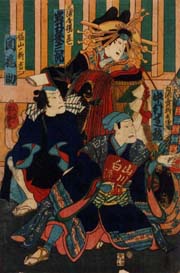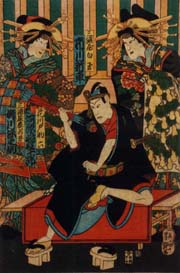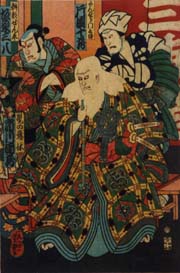| SUKEROKU |
| Play titles | Hana Yakata Aigo Zakura Sukeroku Yukari no Edo Zakura Sukeroku Kuruwa no Momoyogusa Sukeroku J˘mon no Hanabusa Imay˘ Ninin Sukeroku |
||||||||||||
| Common title | Sukeroku |
||||||||||||
| History |
The play "Sukeroku", which was entitled "Hana Yakata Aigo Zakura", was staged for the first time in the 3rd lunar month of 1713 in Edo at the Yamamuraza. The script was written by Tsuuchi Han'emon under the supervision of Tsuuchi Jihŕ II. The roles of Sukeroku, Agemaki, the shirozake seller Shinbŕ and Ikyű were played by Ichikawa Danjűr˘ II, Tamazawa Rin'ya, Ikushima Shingor˘ and Yamanaka Heikur˘ I. A new version was written 3 years later by Tsuuchi Jihŕ II, setting the play in the world of the Soga brothers with Sukeroku, Agemaki and the shirozake seller Shinbŕ being in fact Soga Gor˘ Tokimune, the courtesan Kewaizaka no Sh˘sh˘ and Soga Jűr˘ Sukenari. This new version was performed in the 2nd lunar month of 1716 at the Nakamuraza, starring Ichikawa Danjűr˘ II (Sukeroku), Nakamura Takesabur˘ I (Agemaki), Mimasuya Sukejűr˘ I (Shinbŕ), Sodeoka Masanosuke II (Mank˘ Gozen) and ďtani Hiroemon I (Ikyű). The play "Sukeroku", associated to the Ichikawa Danjűr˘ line of actors, pleased a lot the Edo Audience and was regularly performed, sometimes with the leading role being portrayed by an actor who did not belong to the Naritaya guild. The play was performed under the title of "Sukeroku Yukari no Edo Zakura" for the first time in the 4th lunar month of 1782 at the Ichimuraza (the role of Sukeroku being played by Ichimura Uzaemon IX). The great star Ichikawa Ebiz˘ V listed in 1840 "Sukeroku" as one of the best plays belonging to the Kabuki Jűhachiban collection, ranking in second position below the bombastic play "Shibaraku". |
||||||||||||
| Key words |
Geta Jidaimono Kabuki Jűhachiban Kak˘shű Kiseru Kuruwa Ky˘kaku Mank˘ Gozen Otokodate Shirozake Sogamono Sukerokumono |
||||||||||||
| Summary |
The scene is the center of Edo's licensed red light district. Cherry trees are in full bloom against a hazy spring evening. In front of Miuraya Teahouse are several courtesans who are awaiting their celebrated colleague, Agemaki. They accused Agemaki of being drunk. She protests, but stumbles, and her attendants make her drink some sobering medicine and lead her to a bench to rest. A letter has been delivered to Agemaki. It is from Sukeroku's mother, who tells Agemaki to cast off her son, because he is supposed to be avenging his father's murder, and that it is no time for him to come constantly to the licensed quarters and waste his time in unseemly brawls. But Agemaki loves Sukeroku so deeply that she cannot bear to pass a night without seeing him. In the meantime, one of Agemaki's attendants comes, announcing that the elderly samurai, Ikyű, is on his way to visit her. He has been a slave to her love. Shiratama and other ladies in the district enter and Ikyű, followed by his retainers, comes. He is a vicious old man famous in the quarter for his huge white beard, but he has money and is one of Agemaki's best clients. Ikyű at once begins to abuse Sukeroku, calling him a thief. Agemaki admits that she is perhaps foolish to be in love with Sukeroku, but calling him a thief is too much. Although Shiratama tries to calm her down, Agemaki declared that she will never have anything to do with Ikyű again and withdraws, followed by Shiratama and her attendants. The sound of a flute is heard. Sukeroku enters. The singers chant a love song as he dances. The ladies of the quarter call attention to his purple head band. They crowd around him as he steps onto the stage, offering him tobacco pipes. Ikyű, annoyed at finding himself suddenly deserted, says loudly that he wishes to smoke too, but Sukeroku insolently points out that all the pipes are in use. Sukeroku tries to provoke Ikyű, and after boasting triumphantly of his power over women, offers Ikyű a pipe holding it between his toes. Ikyű is boiling with rage, but prefers not to take up Sukeroku's challenge. At this point one of Ikyű's retainers, Kanpera Mombei, comes out of the house shouting furiously that he has been cheated by an attendant who put him into a bath and left him to stew without joining him there. He turns his anger upon everybody around him. But Kanpera and his colleagues are finally routed by Sukeroku. Then Sukeroku makes a famous speech in which he claims to be the number one person in arms and love. Ikyű's retainers attack him, but he throws them down before their master, challenging Ikyű to draw his sword. However hard Sukeroku tries to make Ikyű lose his temper so that he pulls out his sword, Ikyű never draws it saying that his sword is too noble to be spoiled by a thief's blood. Ikyű, his followers and the courtesans withdraw into the house. When they have gone, the band of ruffians return and set upon Sukeroku, who again disperses them. Among the ruffians is Sukeroku's brother, Shinbŕ, who is disguised as a sake wine-seller. Sukeroku does not know who the wine-seller really is, until Shinbŕ discloses his real identity. He protests to his brother about his behavior and reminds him of his oath, made eighteen years ago, to avenge their father's murder. Sukeroku tells his brother that there is reason in his madness. His treasured sword, which was a heirloom of the Soga family, has been stolen from him, and he comes to Yoshiwara, where all classes of people meet, in hopes of finding it. He picks quarrels with all in order to make them draw their swords. Shinbŕ understands his brother's strategy and offers to help him in the search. Sukeroku tells Shinbŕ that he believes Ikyű must have the sword since he is the only person who has refused to fight. He then gives a lesson in how to insult strange samurai to provoke them. They try it out on some innocent passers-by and together make them crawl between their legs. Agemaki's voice is heard. She leads Soga Mank˘, whose face is hidden under her traveling-hat. Sukeroku tries to pick a quarrel with this supposed samurai and is dumbfounded when he discovers it is his own mother. Soga Mank˘ scolds her two sons for their scandalous behavior. She declares her intention to kill Ikyű and then take her own life. Sukeroku explains the reason for his conduct and shows his firm resolution to kill the family's enemy, Ikyű, who is in fact Iga Heinaizaemon. Soga Mank˘ is overjoyed to find her lack of faith in her sons unjustified. A little later, Ikyű comes out of the house with Shiratama and the others. Sukeroku hides behind Agemaki's skirt as she sits on a bench. Sitting beside Agemaki's skirts Ikyű guesses who must be under the seat and teases Sukeroku, calling him a ditch-rat. At this Sukeroku emerges from his hiding place. Ikyű, calling him by his real name (Soga no Gor˘), reviles him for haunting the licensed quarters when he should be avenging his father. Ikyű now attempts to trick Sukeroku into making treasonous statements against the government, hoping to use this as a means to his own ends. By drawing an example from a three-legged burner, Ikyű suggests that they could strike at their enemy and even the shogun if the two brothers unite steadfastly like the three-legged incense burner, and that, on the contrary, if they lack harmony, nothing can be done. To demonstrate his metaphor he draws his sword and slices the burner in two. Sukeroku stares at the sword. Ikyű is too late to hide it and quickly enters the house. It is the sword that Sukeroku has been searching for. Sukeroku's mission is accomplished. He resolves to attack Ikyű and demand the return of the sword. This summary has been written by Watanabe Hisao and edited by Jeff Blair [website] |
||||||||||||
| Comments |
"The hero, Sukeroku, is an otokodate with all the qualities of courage, resourcefulness, bravado and physical charm which the lower classes admired. Played by Ichikawa Danjűr˘ II, he epitomized all the aspirations of the humble, romantic townsfolk. He even went so far as to wear a head-band dyed with a certain purple dye which, because of the enormous cost of importing it from China, only the Sh˘gun himself had hitherto been accustomed to use. "Sukeroku" in eighteenth-century Edo can be compared with Beaumarchais's "Barbier de Seville" or "Noces de Figaro" in eighteenth-century France; it gave dramatic expression to a certain stirring of the social consciousness of the common people" (Aubrey and Giovanna Halford in "The Kabuki Handbook") The original musical accompaniment was an orchestra belonging to the Icchű Bushi school. It was replaced from 1749 by a Kat˘ Bushi ensemble. The musicians were originally amateurs patronizing the Ichikawa Danjűr˘ line of actors. The tradition survived and nowadays "Sukeroku" is the only play using amateurs for the accompaniment. It is a high privilege for a Kat˘ Bushi ensemble to be selected to play for a "Sukeroku" performance. It is also worth noting that Tokiwazu and Kiyomoto versions of "Sukeroku" exist, the former being composed in 1870 for Onoe Kikugor˘ V and the latter in 1915 for Onoe Kikugor˘ VI. It is a well-established custom for each actor to perform "Sukeroku" with a title belonging to his acting family:
|
 |
 |
 |
|
The actors Seki Hanasuke I, Iwai Kumesabur˘ III, Nakamura Shikan IV, Anegawa Gennosuke, Kawarasaki Gonjűr˘ I, Ichikawa Shinsha I, Band˘ Sanpachi V, Ichikawa Danz˘ VI and Kataoka Jűz˘ I playing the roles of Fukuyama Shinkichi, the courtesan Miuraya Agemaki, the shirozake seller Shinbŕ, the courtesan Makinoi, Hanakawado Sukeroku, the courtesan Miuraya Shiratama, Asagao Senpei, Ikyű and Kanpera Monbei in the drama "Sukeroku Yukari no Edo Zakura", which was performed in the 3rd lunar month of 1862 at the Ichimuraza (print made by Utagawa Yoshitsuya) |
||
| Click on the pictures to enlarge them! | ||
|
|
| Contact | Main | Top | Updates | Actors | Plays | Playwrights | Programs | Links | FAQ | Glossary | Chronology | Illustrations | Prints | Characters | Derivatives | Theaters | Coming soon | News |